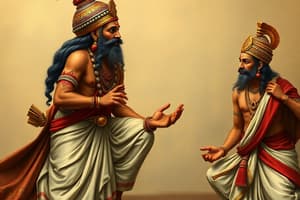Podcast
Questions and Answers
What is the content of Kalidasa's work 'Megha Duta'?
What is the content of Kalidasa's work 'Megha Duta'?
- A narrative about the lineage of Lord Rama
- A description of Lord Kumara's birth and exploits
- A tragic love story between a Yaksha and his beloved
- An epic poem about separation and a message carried by a cloud (correct)
Which work of Kalidasa traces the lineage of Lord Rama?
Which work of Kalidasa traces the lineage of Lord Rama?
- Megha Duta
- Raghuvamsha (correct)
- Kumarasambhava
- Abhijnana Shakuntala
In 'Kumarasambhava', whose birth and exploits are narrated?
In 'Kumarasambhava', whose birth and exploits are narrated?
- Yaksha
- Lord Shiva
- Lord Kumara (Skanda) (correct)
- Lord Rama
Which of Kalidasa's works is known for expressive descriptions of landscapes and emotions?
Which of Kalidasa's works is known for expressive descriptions of landscapes and emotions?
In addition to 'Abhijnana Shakuntala', which work is credited to Kalidasa?
In addition to 'Abhijnana Shakuntala', which work is credited to Kalidasa?
What does 'Kumarasambhava' narrate?
What does 'Kumarasambhava' narrate?
What are the two Mahakavyas composed by Kalidasa?
What are the two Mahakavyas composed by Kalidasa?
Which play by Kalidasa focuses on the love story between King Dushyanta and Shakuntala?
Which play by Kalidasa focuses on the love story between King Dushyanta and Shakuntala?
Which one of the following is NOT a work by Kalidasa?
Which one of the following is NOT a work by Kalidasa?
Kalidasa is often known as:
Kalidasa is often known as:
In his compositions, whom does Kalidasa pray to first?
In his compositions, whom does Kalidasa pray to first?
Which of the following is NOT one of Kalidasa's Khandakavyas?
Which of the following is NOT one of Kalidasa's Khandakavyas?
What qualities did the ideal king possess?
What qualities did the ideal king possess?
Why did Dilipa hand over the Government to the ministers?
Why did Dilipa hand over the Government to the ministers?
How did the people view the ideal king?
How did the people view the ideal king?
What was the ideal king's approach towards taxes?
What was the ideal king's approach towards taxes?
How did the ideal king ensure the well-being of his kingdom?
How did the ideal king ensure the well-being of his kingdom?
Why did Dilipa go to the hermitage of his Guru, Vasishtha?
Why did Dilipa go to the hermitage of his Guru, Vasishtha?
Flashcards
What is 'Megha Duta'?
What is 'Megha Duta'?
An epic poem by Kalidasa that tells of love and a message sent via cloud.
What is Raghuvamsha?
What is Raghuvamsha?
A work by Kalidasa that traces the genealogy of Lord Rama.
What is 'Kumarasambhava' about?
What is 'Kumarasambhava' about?
The birth and heroic deeds of Lord Kumara (Skanda).
What is special about 'Megha Duta'?
What is special about 'Megha Duta'?
Signup and view all the flashcards
What is 'Abhijnana Shakuntala'?
What is 'Abhijnana Shakuntala'?
Signup and view all the flashcards
Kalidasa's Mahakavyas
Kalidasa's Mahakavyas
Signup and view all the flashcards
Kalidasa is known as:
Kalidasa is known as:
Signup and view all the flashcards
Kalidasa's first prayer
Kalidasa's first prayer
Signup and view all the flashcards
Qualities of an ideal king
Qualities of an ideal king
Signup and view all the flashcards
Why Dilipa handed power to ministers
Why Dilipa handed power to ministers
Signup and view all the flashcards
How people viewed the ideal king
How people viewed the ideal king
Signup and view all the flashcards
How kings approached taxes
How kings approached taxes
Signup and view all the flashcards
Ensuring well-being of kingdom
Ensuring well-being of kingdom
Signup and view all the flashcards
Dilipa at hermitage
Dilipa at hermitage
Signup and view all the flashcards
Study Notes
Kalidasa's Works and Impact
- Kalidasa's notable works include "Megha Duta" (The Cloud Messenger), "Raghuvamsha", and "Kumarasambhava".
- His works have been translated into numerous languages and have influenced various art forms, including dance, drama, and visual arts.
- Kalidasa's legacy showcases the timeless beauty of his words and profound insights into the human experience.
Kalidasa's Life and Characteristics
- Kalidasa lived in ancient India, believed to be around the 4th-5th century CE.
- He was regarded as the greatest poet and playwright in classical Sanskrit literature.
- He was known as "उपमा कालिदास:" and "कववकुिगरु ु :".
- He was one of the Navaratnas in the court of King Vikramaditya of Ujjain.
"Abhijnana Shakuntala"
- "Abhijnana Shakuntala" is a masterpiece that represents Kalidasa's poetic brilliance.
- The play revolves around the love story between King Dushyanta and Shakuntala, a beautiful maiden.
- Kalidasa's lyrical verses vividly portray the beauty of nature, human emotions, and the complexities of love.
King Dilipa
- Dilipa possessed a strong and well-built body, capable of discharging his duties as a king.
- He was an ideal king who possessed most of the family traits mentioned before.
- He handed over the Government to the ministers and went with his wife to the hermitage of his Guru, Vasishtha, to perform religious rites to get a progeny.
Studying That Suits You
Use AI to generate personalized quizzes and flashcards to suit your learning preferences.




